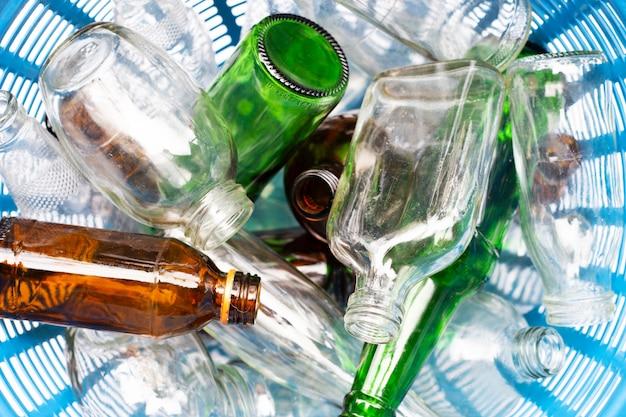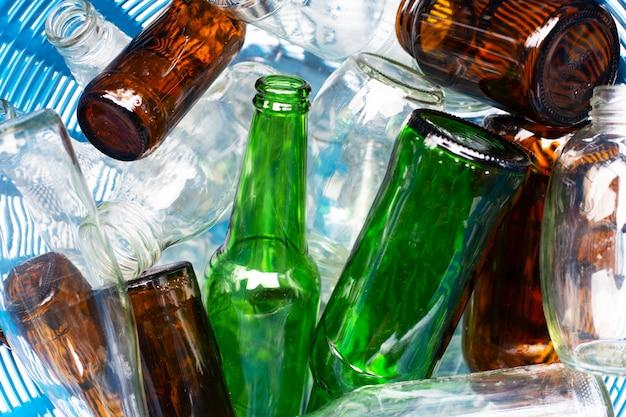Glass bottles have long been a popular packaging choice for various beverages, from juices and sodas to wines and spirits. While glass is known for its durability and its ability to preserve the flavor of its contents, it’s important to consider the environmental implications of using glass bottles. In this blog post, we will delve into how glass bottles affect the environment and explore the role of recycling in mitigating their ecological footprint.
Glass recycling is often hailed as a sustainable solution, but how does it actually impact global warming? Is glass recycling on the decline, and if so, why? These are just a few questions we’ll address as we examine the relationship between glass bottles and the environment. Additionally, we’ll touch upon the recyclability of different types of glass and explore alternative measures to minimize our reliance on glass packaging.
Join us as we explore the world of glass bottles and their environmental impact. Together, we can gain a better understanding of the choices we make and work towards a more sustainable future.

How Glass Bottles Impact Our Environment
Glass bottles have become a staple in our everyday lives – from holding our favorite drinks to preserving our grandmother’s secret sauce recipe. But have you ever stopped to think about the impact these seemingly harmless vessels have on the environment? Prepare to have your mind blown (but not like a shattered bottle) as we dive into the world of glass bottles and their environmental footprint.
The Heavyweight Champions of Emissions
When it comes to greenhouse gas emissions, glass bottles are true heavyweights. The production of glass requires high levels of energy, often derived from fossil fuels, which contribute to the release of harmful carbon dioxide (CO2) into our atmosphere. Even though glass is infinitely recyclable, the energy-intensive process of recycling still results in emissions, although at a lower rate compared to creating new glass.
A Never-Ending (but not in a good way) Decomposition Story
Unlike your last break-up, glass bottles do not break down easily. In fact, they can take over 1,000 years to decompose naturally. That means the beer bottle you chucked in frustration during a heated argument could still be sitting pretty in the landfill, mocking you, long after you’re gone.
Recycling: The Magic Potion
While the decomposition time of glass bottles is equivalent to several human lifetimes, recycling them can be a game-changer. When you toss your empty glass bottle into the recycling bin, you’re not only reducing landfill waste, but you’re also conserving energy. Recycled glass requires less energy to melt down and reshape compared to virgin glass production. Plus, recycling glass helps conserve precious natural resources like sand and soda ash, which are used in the manufacturing process.
Glass Bottles’ Journey to the Grave
After we’re done enjoying our favorite beverages, the journey of the glass bottle continues. Unfortunately, not all of them end up on the yellow brick road of recycling. Some glass bottles, like Cinderella’s step-sisters, are abandoned in the trash. These lonely bottles make their way to landfills, contributing to the growing mound of waste that taunts our environment.
Shattered Dreams of Wildlife
The impact of glass bottles isn’t limited to landfills, though. When glass bottles are carelessly discarded, they can pose a serious threat to wildlife. Broken glass fragments can become sharp, dangerous obstacles for animals who unknowingly traverse them. The shattered dreams of small creatures can be avoided by disposing of glass bottles responsibly and with consideration for our furry and feathery friends.
Tips and Tricks to Lighten Your (Glass Bottle) Load
Reducing our dependence on glass bottles is an important step towards a greener future. Here are a few tips and tricks to help you take a small but significant leap towards making a positive environmental impact:
1. Choose Alternatives: Opt for drinks packaged in cans or cartons instead of glass bottles when available. You’ll be sipping your morning juice guilt-free, knowing you’ve made a more eco-friendly choice.
2. Embrace Refillables: Invest in refillable glass bottles or containers for storing your homemade beverages or bulk products. Not only will you reduce packaging waste, but you’ll also save some pennies along the way.
3. Recycle Like a Pro: Always make sure to recycle your glass bottles properly. Follow your local recycling guidelines and rinse out any residue before tossing them into the recycling bin. It’s like giving your glass bottles a spa day before their next reincarnation.
4. Get Creative: Instead of tossing out glass bottles, get crafty! Upcycle them into beautiful vases, storage containers, or even unique lighting fixtures. Let your creativity shine while reducing waste.
Glass Half Full or Half Empty
As we raise a glass (but, uh, maybe not a glass bottle) to the end of our journey through the environmental impact of glass bottles, we realize that the choice is in our hands. By understanding the consequences of our choices and adopting more sustainable habits, we can ensure a future where both beverages and the environment can coexist harmoniously. So, let’s drink responsibly, recycle diligently, and show some love to our wonderful planet. Cheers!

FAQ: How do Glass Bottles Impact the Environment?
Glass bottles have become an essential part of our daily lives, making appearances at parties, gatherings, and even sneaky midnight snacks. But have you ever wondered how these lustrous beauties affect the environment? In this comprehensive FAQ-style section, we’ll explore the burning questions surrounding the environmental impact of glass bottles. So grab your imaginary popcorn and let’s dive in!
How does Recycling Glass Affect Global Warming
Glass recycling is like hitting two birds with one stone, except in a more eco-friendly way (we don’t condone violence here!). By recycling glass bottles, we can significantly reduce the release of greenhouse gases, including carbon dioxide, into the atmosphere. When glass is melted down to be reused, it requires less energy compared to producing glass from scratch. This energy-saving process means fewer fossil fuels burned, resulting in reduced carbon emissions and a positive impact on global warming. So it’s time to give a toast to recycling!
Why is Glass Recycling Going Away
Wait, what? Is this happening? Unfortunately, it’s no secret that the glass recycling industry has faced some challenges lately. It’s like the Harry Potter of recycling – often overlooked and underappreciated. The primary issue lies in contamination – when non-glass materials, such as plastic or metal, sneak into the recycling bin (oh, you sneaky little devils!). This contamination makes it difficult and costly to separate and process glass. Consequently, some recycling programs have scaled back on glass recycling. But fear not! It’s still crucial to recycle glass and support local efforts to keep this magical material in the circle of life (cue The Lion King soundtrack).
How do Glass Bottles Affect the Environment
Ah, the million-dollar question! Glass bottles can have both positive and negative effects on our environment, like a double-edged sword, but without the sword part (no violence, remember?). On the bright side, glass is made from abundant materials like sand, limestone, and soda ash – no rare rainforest gems needed here. Glass is also 100% recyclable, which means it can be endlessly transformed into new bottles and other glass products. However, glass production and transportation require substantial energy inputs, contributing to carbon emissions. Additionally, glass can take thousands of years to decompose when left in a landfill, clogging up space and preventing Mother Nature from doing her job. So it’s essential to handle glass bottles responsibly and practice the three R’s: Reduce, Reuse, and Recycle.
Can Brown Glass be Recycled
Did you know brown glass shares the same recycling party as green and clear glass? Yes, brown glass bottles are more than just a cool fashion statement at a trendy beverage party. Whether you’re sipping from a small brown medicine bottle or chugging down your favorite craft beer, brown glass bottles are fully recyclable. Just toss them into the recycling bin (gently, please) and let the glass recycling magic do its thing!
How does Recycling Help Slow Down Global Warming
Recycling is like a superhero team fighting against global warming (cue epic Marvel film score!). By recycling materials, including glass bottles, we can significantly reduce the need for extracting and manufacturing new raw materials. This reduction in production directly translates into fewer carbon emissions, water pollution, and energy consumption. When it comes to glass recycling, reusing this shimmering material saves up to 30% of the energy required to make brand new glass. And hey, less energy used means fewer fossil fuels burned and a slower global warming party. Who needs a hot and sweaty planet anyway?
What Type of Glass Cannot be Recycled
Now here’s a little secret: not all glass is created equal when it comes to recycling. While most glass bottles can be recycled, a few exceptions sneak their way onto the not-so-recyclable list. Ceramics, like coffee mugs or flower vases, have an unruly composition that doesn’t play well in the recycling process. Light bulbs, windows, mirrors, and Pyrex dishes should also be showcased in the “do not recycle” museum (right next to that questionable hairstyle from the ’80s). So when in doubt, make sure to check your local recycling guidelines to ensure you’re recycling the right kind of glass.
Are Glass Bottles Environmentally Friendly
Ah, the age-old question of whether glass bottles should be considered Mother Earth’s eco-warriors or undercover environmental villains. On one hand, glass is endlessly recyclable and poses fewer risks to human health than plastic. However, glass production requires significant energy inputs, contributing to carbon emissions and mining impacts. Additionally, transportation logistics can add to the overall environmental footprint of glass bottles. So while glass bottles have their pros and cons, it’s essential to handle them responsibly, reduce unnecessary consumption, and always opt for recycling. Cheers to mindful choices!
How does Waste Contribute to Carbon Footprint
Oh, waste – the inevitable side effect of our modern lifestyles. Unfortunately, waste isn’t just an eyesore; it also leaves a carbon footprint as noticeable as a toddler covered in finger paint. When organic waste, like food scraps and yard trimmings, ends up in landfills, it decomposes anaerobically, releasing potent greenhouse gases like methane. Plastics also play a villainous role, as they aren’t easily biodegradable and often persist for hundreds of years, emitting harmful emissions along the way. By reducing waste, especially through recycling and composting, we can significantly slash our carbon footprint and help combat climate change. So let’s all do our part and aim for wasteless greatness!
How Can We Reduce the Use of Glass
Reducing the use of glass doesn’t mean banishing it from our lives forever – we’re not heartless monsters! Instead, we can employ a few tricks to minimize our glass consumption. One way is to opt for refillable glass containers for products like liquid soap, oil, or beverages. By refilling these containers, we reduce waste and the demand for new glass production. Another option is to choose products packaged in other materials like aluminum or paper, which often have a lower carbon footprint than glass. And of course, let’s not forget the good ol’ 3R’s: Reduce, Reuse, and Recycle. By being mindful of our choices, we can all contribute to a glass-efficient, bottle-saving world!
